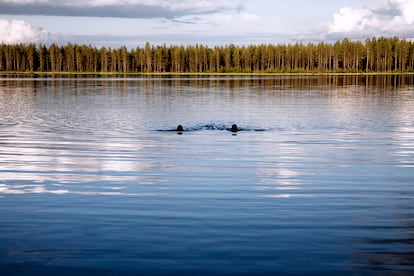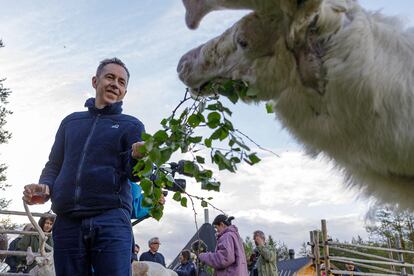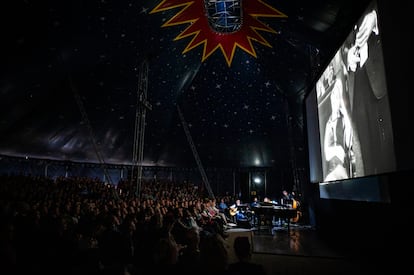The landscape changes like in a road movie in the thousand kilometers that you have to travel from the south to the north of Finland to reach one of the most peculiar cultural events of the summer in Northern Europe. The Midnight Sun Film Festival, in Sodankylä, stands out for the presence of great international directors and the careful selection of films, between classics and contemporary premieres. But also, or above all, because of its location: a town of 8,000 inhabitants and a few reindeer, where it never gets dark these days.
Upon reaching Sodankylä, the magic of these uninhabited lands overwhelms the mind. Finland’s dense forests become lower and the bogs wilder. The Arctic Circle is crossed and the path heads towards the blue silhouette of the Lapland mountains. The sky seems to be close and the sun accompanies travelers day and night. The reindeer graze on the sides of the road and cross it at will, forcing cars to stop. We have arrived at the lands of the midnight sun, as the atmospheric phenomenon is known that floods the area with light for a few days. And to the film festival conceived 39 years ago by the municipality of Sodankylä and the most famous brothers of Finnish cinema, Aki and Mika Kaurismäki.
The presence of renowned guests increases the prestige of the event, whose last edition has just ended. This year the Frenchman Léos Carax was there, with films like Holy Motors o Annette, the Mexican Alfonso Cuarón, who took to Lapland Roma o And Your Mother Too, the Turkish-German Asli Özgen or the Italian Alice Rohrwacher, among others. “The images inspire me. The first movie I saw, as a child, was bicycle thief by Vittorio de Sica. I loved. Now I am fascinated, for example, by the cinema of Alice Rohrwacher. What a joy to talk here with colleagues like her. This is a festival for directors too,” says Cuarón in Sodankylä.

In this event, the filmmakers also chat with the public, without red carpets or VIP rooms. There is no room for luxury and glamor in the ticket sales lines. There are the film professionals, along with amateurs and local residents, who the trained eye recognizes waiting with the traditional Finnish country dogs at their side. They are never seen in cities.
The festival has broken down walls between elites and the people. The atmosphere in Sodankylä evokes the worn-out slogan connecting people, created by another originally Finnish invention, the Nokia company. The rural community that lives off the Kevitsa copper and nickel mine has seen big stars pass through its streets. Carlos Saura, Mario Monicelli, Claire Denis, Milos Forman and Francis Ford Coppola, among many others, over almost four decades. A Finnish film buff, Michael Walin, from Helsinki, shares: “I remember Saura sitting in the corner café. Many here didn’t even know it was him. He was modest and kind.”
Among so many relevant visitors, no one expects the Finnish Government. Rather the complete opposite. The artistic director of the festival, Timo Malmi, summarizes the sentiments of many local artists about the country’s conservative Executive: “The tremendous popularity of the festival contrasts with the Government’s indifference to culture.” He refers to cuts of more than four million euros for the arts in the current state budget. And he remembers the words of the Minister of Economy, Riikka Purra, leader of the far-right Authentic Finns, who, in the 2023 parliamentary elections, stated: “Culture is a luxury service.” The indignation of the artists was resounding. They probably do not regret that their party was one of the big vote losers in Finland in the recent European Parliament elections.

Russian filmmakers no longer attend either. From Sodankylä to the border with Russia it is only about 200 kilometers. The military attack on Ukraine by Vladimir Putin’s armed forces was a death blow to the collaboration between Russian and Finnish directors. Before the war, people came and went and crossed the border without problems. Between the artists of both countries there was respect, affection and constant official programs to work together, financed by both States and the EU. All of that was closed, as was the border, the longest of the EU countries with Russia, which is now highly guarded.
The contest, however, welcomes many local creators. Although perhaps the most anticipated Finnish guest was director Katja Gauriloff. In Sodankylä, her new award-winning film was shown in black and white, and in the Kolttsámi language, Je’vida. It is the story of a girl, Je’vida, whose identity from the village of Kolttsámi, an ethnic minority in Lapland, was destroyed by the Finnish education system in the 1950s. At that time, little Sámi children were not allowed to express themselves in their native language at school, even if they did not know how to speak Finnish. The authorities even changed their original names. “The story is inspired by childhood and my mother’s letters. It was difficult to find a girl capable of playing this role: we have very few who speak our language,” says Gauriloff, who is also Kolttsámi. “But I don’t think she’s going extinct. The tension between the Kolttsámi and the Finnish state still exists, but now we have education services in our language for our children,” she adds.

Projections, such as Je’vida, They take place in the town’s old movie theater, in open-air tents, and at the school. There is an offer for children too. It is possible to watch movies for 24 hours. After months of complete darkness in the winter, Lapland experiences the celebration of San Juan, the largest summer festival in the hemisphere. It’s easy to forget the time. There is no night. The Sun pretends to set and goes down a little to then rise again in an eternal ping-pong with the earth.
In a sequence of The Worthlessand volga burgundy roars ferociously as it barrels through the streets and dirt roads of 1980s Finland. In the film, directed in 1982 by the Kaurismäki brothers, a country appears on the eve of the recession of the nineties, beautiful, harsh and somewhat cruel. At the beginning of the film, the anthem Finland, by Jean Sibelius, is heard through a harsh rock band. All accompanied by aerial shots of a country that no longer exists. Finland modernized, integrated into the EU and NATO. American soldiers arrived in Lapland. They brought weapons and devastated the muffins in cafes.
These days, in Sodankylä, Mika Kaurismäki took the stage of the Big Tent with the protagonist of The Worthless, Pirkko Hämäläinen. And he revealed how he came up with the idea for his famous film: “In 1982, at the age of 27, I arrived in Helsinki on a plane from Munich, where I studied film. Sibelius’ Finland played at full volume in the cabin. I felt like we had to change everything.” They did it. They opened doors. They broke with tradition. They made Finland and its cinema international. Until then, in the theaters, there had been stories of the traumas of World War II and melodramas about lumberjacks who, through the rivers of Finland, brought the logs of the local green gold, wood, to the industrial centers of the south. Today, the festival promoted by the Kaurismäki sums up a new mix: the reindeer, the swamps and the forests are still there. But in Sodankylä there is already another regular neighbor: international cinema.
Subscribe to continue reading
Read without limits
_

